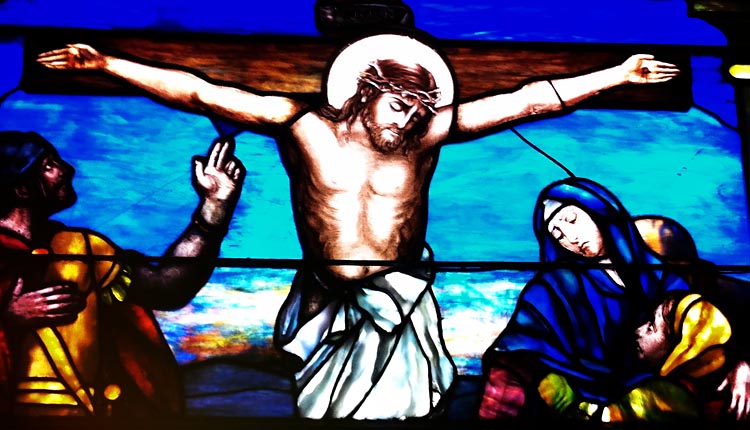The Beloved Disciple
by:Worth Green, Th.M., D.Min.
This morning, I want to talk about the “the disciple whom Jesus loved,” also known as “the Beloved Disciple.” This reference appears only in the 4th Gospel, and it appears only four times in three incidents. (See Footnote 1) The thee specific references to the Beloved Disciple vary greatly in tone.
The first incident is sad beyond words, so sad, in fact that the multitudes of those who saw it went away beating their breast. But two went away, hand in hand, a new family.
In John 19:26-27, Jesus, is dying. His agony is almost over. Like many who are approaching death, his thoughts turn to the welfare of his family, in this case his mother. In the 4th Gospel Jesus is Fully Divine and Fully Human. In this incident his Divinity mirrors and adds Divine approval to our own concerns. The text declares:
26 When Jesus saw his mother, and the disciple whom he loved standing near, he said to his mother, “Woman, behold, your son!” 27 Then he said to the disciple, “Behold, your mother!” And from that hour the disciple took her to his own home.
In 4th Gospel Jesus is the Eternal Word though whom and for whom God created “all things.”
In the beginning was the Word, and the Word was with God, and the Word was God. All things were made by him, and without him was not anything made that was made….and the Word became Flesh and dwelt among us. (John 1:1-14)
In this last act of creation. Jesus creates a new family between his mother and his friend. Not a new type of family, a new family; this type of family has always existed.
[9:00 AM Service of April 22nd] This act reminds us that families are not always about sex, but families are always about caring. Family exist where two or more people care for one another. Likewise, it reminds us that some families are given—through no choice of our own; and some families are all about choice and freedom. We Moravian’s recognize the Christian family by calling one another brother and sisters, so does the 4th Gospel. Quakers recognize the Christian family by calling one another “Friends.” This comes from the 3rd Epistle of John, in which we read, “The friends greet you…greet the friends.” Some families are about relationship and responsibility: “Home is the place where, when you have to go there, they have to take you in.” (Robert Frost, “Death of the Hired Man.” But family is also about freedom and choice. Friends are the family you choose. One of my goals in life is to be absolutely faithful to my friends, as far as it lies within me and my power to do so. [End 9:00 AM Service]
[11:10 AM Service of April 15th] Let me say a word about family. When we hear the word “family,”we immediately think “marriage and family,” or, perhaps “a nuclear family,” with a father, a mother, and two children, or, perhaps, “a blended family,” or even “a single parent family.” The truth is that were any two people like, Mary the Mother of Jesus and the Beloved Disciple care for one another, there is family. Soldiers call one another, “brother,” and now, “sister.” Church members call one another “brothers and sisters.” Paul advised his young friend Timothy that he ought to treat the older women like “mothers.” (1st Timothy 5:2) Family does not have to be about sex. Jesus gave his mother a new son, and his disciple a new mother. That was not about sex, and this rule still applies. Some of you know my friend Ron. Ron and I have always agreed that we married way beyond ourselves. And we have frequently Joked that if our wives ever got smart and abandoned us—unlikely because they are who they are, he and I would have to live together because we both need help, and no one else would have us. We would be like Neil Simon’s “Odd Couple.” He would be Felix Unger, the neat freak, and gourmet cook; and I would be Oscar Madison, the messy one, who eats beanie weenies out of a can. As a family we ought to have all the rights of a family under the law. We ought to be able to be with one another in the hospital, and file a joint tax return, like we were a business, and do all the things that families do. In today’s world lots of people are forming families. There are now dozens of organization which help single women form partnerships for the sake of raising their children because they cannot physically or financially afford to do it any other way. Again, it is not about sex, it is about giving one another nurture, and support. Jesus created an atypical family, and we ought to recognize and support that. You don’t have to be married to have a family.[End 11:10 AM Service]
The second incident in which the Beloved Disciple is named is profoundly perplexing.
It was the first day of the week. Mary Magdalene came to the tomb early, while it was still dark, and saw that the stone had been taken away. So she ran, and went to Simon Peter and the other disciple, the one whom Jesus loved, and said to them, “They have taken the Lord out of the tomb, and we do not know where they have laid him.”
Note the language—not “the body of the Lord,” but “the Lord.” At this time the Jews believed that a person existed body, mind, spirit, soul. When the body was dead, the person was dead, and only God could restore the life. There was no soul that survived the death of the body out of some built in necessity as in Greek thought.
Peter then came out with the other disciple, and they went toward the tomb. They both ran, but the other disciple outran Peter and reached the tomb first; and stooping to look in, he saw the linen cloths lying there, but he did not go in. Then Simon Peter came, following him, and went into the tomb; he saw the linen cloths lying, and the napkin, which had been on his head, not lying with the linen cloths but rolled up in a place by itself. In the 4th Gospel there is a great contrast between this arrangement of the grave clothes, and the grave clothes on Lazarus. When Jesus called Lazarus out of the tomb his hands and feet still bound with bandages, and his face wrapped with a cloth. Jesus had to say, “Unbind him, and let him go.” (John 11:44) Not so with Jesus. In his book “Basic Christianity” John R. W. Stott says that the grave clothes had simply collapsed upon themselves, as if Jesus had just passed through his bandages. The author wants us to know that Lazarus was resuscitated, and Jesus was raised from the dead and transformed to a new order of being. He is the first to attaint to this kind of life—but he is also the “first fruits,” and will not be the last. Then the other disciple, who reached the tomb first, also went in, and the text says, “…and he saw and believed; for as yet they did not know the scripture, that he must rise from the dead.” Then the disciples went back to their homes, each to his own home, because each had things to think about and people to tell. The Beloved Disciple had to tell the mother of Jesus about these strange happenings.
Now let me ask you a question. I will make it multiple choice. When the Beloved disciples saw the empty tomb and the arrangement of the napkin and the linen cloths what did the Beloved Disciple believe? Did he : A) Believe the report of Mary Magdalene that someone had taken the body of the Jesus out of the tomb and put it where his disciples could not find it? Or, B) did he become the first to believe in the resurrection of Jesus even before he actually saw the Risen Christ?
Some of the time I believe that A) is more likely. That the beloved disciple believed Mary’s report of the body being lost. Nowhere else in the four Gospels does the empty tomb produce faith in the Resurrection of Jesus. In the gospels it is always an appearance of the Risen Christ that produces faith. In addition the text implies that the disciples were perplexed by the empty tomb because, and I quote, “…as yet they did not know the scripture that he must rise from the dead.” Does this verse apply to Peter and To John? Or, does it apply to Peter only? The 4th Gospel which is always comparing and contrasting Peter with the Beloved Disciple permits either choice. It almost encourages the reader to remain as perplexed about this incident as Peter himself once was. I think this passage is concerned with more than a foot race. It is concerned with a race to faith; and, according to the 4th Gospel, the Beloved Disciple may even have beat Peter, preeminent among all the disciples, to it!
The third incident in which the Beloved Disciple is named profoundly joyful.
By this time the disciples know that Jesus is Alive! After having seen the Risen Lord at least twice in the company of all the other disciples—Peter says, “I am going fishing.” (See Footnote 2) And six of the other disciples say, “We will go with you.” And they went fishing on the Sea of Tiberias, and they toiled all night, and took nothing. The next morningl a stranger on the beach told them to cast their nets on the right side of the boat, and they snagged a great quantity of fish. And then that disciple whom Jesus loved said to Peter, “It is the Lord!” And Peter, who had stripped to work, put on his clothes, and dived into the sea, and swam to Jesus.” And the other disciples follow in the boat, dragging the net, and when they finally reached the beach, they had caught 153 fish. And this figure is given not because they stopped to count, but because, at that time, there were 153 known people groups upon the earth. And the disciples see the stranger, and they are afraid to say, “Who are you?” for they know it is the Lord. And they eat breakfast.
And When they had finished breakfast, Jesus and Simon Peter took a walk—which is obvious from the context of the passage, and Jesus said to Simon Peter, “Simon, son of John, do you love me more than these?” He said to him, “Yes, Lord; you know that I love you.” Jesus said to him, “Feed my lambs.” A second time Jesus said to Peter, “Simon, son of John, do you love me?” He said to him, “Yes, Lord; you know that I love you.” Jesus said to him, “Tend my sheep.” 17 Jesus said to Simon Peter the third time, “Simon, son of John, do you love me?” Peter was grieved because he said to him the third time, “Do you love me?” Perhaps he was also grieved because Jesus no longer spoke of the love of passion “agape”, but of friendship and free choice, “filia.” And Peter said to him, “Lord, you know everything; you know that I love you.” Jesus said to him, “Feed my sheep.
Then the Lord who now know everything speaks of Peter’s death. He says:
“Truly, truly, I say to you, when you were young, you girded yourself and walked where you would; but when you are old, you will stretch out your hands, and another will gird you and carry you where you do not wish to go.”
The text adds that Jesus said to show by what death Peter was to glorify God. And those who first read this gospel know all about that death, but it is lost to us, except for the tradition that Peter died in Rome, under Nero, and that he was crucified upside down because he refused to be crucified in the same manner of his Lord. And even this is just tradition, not scripture. And after Jesus said this to Peter, he said, “Follow me.”
And then Peter turned around and saw the disciple whom Jesus loved, who had lain close to his breast at the supper and had said, “Lord, who is it that is going to betray you?” And When Peter saw him, he said to Jesus, “Lord, what about this man?” Jesus said to him, “If it is my will that he remain until I come, what is that to you? Follow me!” And John 21:23 declares:
The saying spread abroad among the brethren that this disciple was not to die; yet Jesus did not say to him that he was not to die, but, “If it is my will that he remain until I come, what is that to you?”
This is the whole point of John 21—which is added to the gospel that originally closed with John 20:30. The Beloved Disciple has died and people need to be reassured that Jesus did not break a promise he made to him and through him to all disciples. Jesus did not promise to come back in the lifetime of the Beloved Apostle.
And John 21:24 adds:
This is the disciple who is bearing witness to these things, and who has written these things; and we know that his testimony is true.
Notice, the Beloved disciples is the author, and the witness. If writing is authorship, he was an author in a modest way. He could not have written chapter 21, or Chapter 19:28-36, where he is called upon as atruthful witness. Likewise, the gospel appears to be from a single hand. Rather the the Beloved Disciple is the authority, the witness, behind the gospel, and by his testimony we know.
No doubt the Beloved Disciple was present when John the Baptist called Jesus, “The Lamb of God.” (John 1:36-40) (See Footnote 1) No doubt the Beloved Disciple ate the Last Supper, lying near Jesus, and reports the exchange that took place between Jesus and Judas. The Beloved Disciple was there at the foot of the cross to become a new family with the Mother of Jesus. And since we know that he was a the foot of the cross, and since chapter 21 calls attention to his role as “witness,” there can be little doubt that it was he who saw the soldier pierce the side of Jesus with his spear. No doubt he was a primary witness to the Resurrection of Jesus—seeing the Risen Christ on at least three occasions, and probably more. And, since the Beloved Disciple beat Peter in a foot race to the empty tomb, we can assume the Beloved Disciple was younger (or at least faster) than Peter. Scholars unanimously agree that the 4th Gospel was the last gospel to be written, and most agree that the authority behind the 4th Gospel was undoubtedly the last of the first generation of witnesses to die. This would account for the concerns of chapter 21.
Now who is the Beloved Disciple? I cannot close this sermon without out point out that the identity of the beloved disciple has never been fully established. The gospel never calls him by name. All we can definitively say is that according to John 21 the Beloved Disciple is one of the six disciples who went fishing with Peter: Thomas the Twin, Nathanael of Cana, and “the sons of Zebedee,” unnamed in this context, but whom we know to be James and John; and “two others of his disciples.” (John 21:2)
For many centuries, Christians associated the Beloved Disciple with John the Son of Zebedee, who supposedly lived to a ripe old age, dying in Ephesus, c. 96 AD. They say that he was the authority behind the 4th Gospel, and that another John, John the Elder, was the author, and that the rest of the Johannine literature—the three epistles and the Revelation, is divided between them.
Then, in the 20th Century, that notion was challenged. Some scholars suggested that the Beloved Disciple was not only not John, but not even one of the twelve. He the disciple with the identity that must forever remain secret, he is one of the “two others of the disciples.”
So, which is it? What do I think? At one time, I thought the Beloved Disciple was someone other than John, but I have now come back around to the traditional view. Both Matthew (Matthew 26:20) and Mark (Mark 14:17) tell us that Jesus ate the last supper with the twelve, and I think they mean this number to be exclusive. More importantly, I am quite sure that whoever wrote the 4th Gospel wanted us to identify the Beloved Disciple with John the Son of Zebedee. The details of the case can be argued, but once they are sorted out we are left with the fact that, in the 4th Gospel, the Beloved Disciple is often with Peter, and yet is contrasted with Peter. That was the situation in the early Church as we know it from Paul’s letter to the Galatians in which Paul names Peter and John as Pillars of the church in the Jerusalem, along side James the Brother of the Lord. (Galatians 2:9, etc.) James the son of Zebedee, the brother of John was already dead, killed by the sword. (Acts 12:2)
Matthew tells us that Jesus placed unusual trust in Peter, yet all the gospels agree that Peter denied Jesus not once but thrice. In John Jesus has to coax a confession of love from Peter. Yet the Beloved Disciple loved Jesus so much that he was next to him during the Last Supper, stood so close to the cross that Jesus could speak to him, waited with him until his death, and took the Mother of Jesus into his own home.
Now what about that name, “the Beloved disciple?” That answer is easy. Jesus did not give the disciple that name. He did not say to him, “Hey, I love all these guys, but I love you the most.” More than likely, the Beloved Disciple thought of himself as “the disciple whom Jesus loved.” He was so overwhelmed with the love and care that Jesus had given him, that he sometimes felt that Jesus loved him like he was the only person in the world, Yet, the Beloved Disciple would have been quick to add that Jesus loved all the disciples, and all of us, with a love that was equal to the love he gave him. It was he who wrote, “For God so loved the World that he gave his only begotten Son.” (John 3:16) And it was he who recorded the word of Jesus to his disciples:
13 Greater love has no man than this, that a man lay down his life for his friends. 14 You are my friends if you do what I command you. 15 No longer do I call you servants, for the servant does not know what his master is doing; but I have called you friends, for all that I have heard from my Father I have made known to you. 16 You did not choose me, but I chose you and appointed you that you should go and bear fruit and that your fruit should abide; so that whatever you ask the Father in my name, he may give it to you. 17 This I command you, to love one another. John 15:12-17)
Perhaps the Beloved Disciple differed from his peers simply because he had a greater capacity to receive the love that God has for all of us in the person of his Son.
Footnotes:
1. There may be two additional times in the 4th Gospel when the Beloved Disciple is referred to as an unnamed disciple. The first unnamed disciple was with Andrew when John the Baptist called Jesus, “The Lamb of God.” (John 1:36-40) Two other unnamed disciples appear along with five named disciples as “Two others of the disciples” when the seven saw the Risen Jesus by on the shores of the Sea of Tiberias (John 21: 2)
2. By this time, the disciples have heard the declaration of Mary Magdalene, “I have seen the Lord.” As a group they themselves have seen the Lord on two occasions. Both times they were in a locked room, when Jesus came to them and showed them his hands and his side. He breathed his Holy Spirit upon them, and commissioned them, saying, “As the Father has sent me, even so I send you.” In John 20 we read that the first appearances of Jesus to his disciples, as a group, occurred on the evening of the First Easter day, a Sunday. We also read that 8 days later, on a Monday, he appeared to them a second time. This is the time when Thomas, who was not with them when Jesus appeared to them and did not believe the report of the others, saw and confessed the Risen Christ for himself, saying, “My Lord and My God!” Then there is an undefined lapse of time—whether long or short, we do not know; between these first two appearances, and the appearance on the shores of the Sea of Tiberias in chapter 21. We should also note that both Paul (1st Corinthians 15:3-11) and two of the synoptics give priority to the tradition that Jesus appeared to Peter (Mark 16:7 Luke 24:34). When the author of the 4th Gospel says that Jesus appeared to the disciples as a group on one, two or three occasions, he does not rule out other individual appearances. As evidence I would advance the fact that he does not count the appearance of Jesus to Mary Magdalene in the garden (John 20:11-18) in the “three” appearances. So,too, in Chapter 20:30 he writes:
30 Now Jesus did many other signs in the presence of the disciples, which are not written in this book; 31 but these are written that you may believe that Jesus is the Christ, the Son of God, and that believing you may have life in his name.
3. This is so wether the Last Supper is a Passover Meal and included the institution of the Lord’s Supper, as in the Synoptics, or is without the institution of the Holy Supper as in the 4th Gospel.







